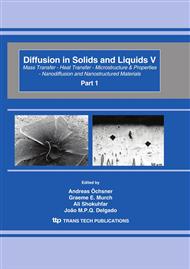[1]
T.P. Schmalzried, M. Jasty, W.H. Harris: J. Bone Jt. Surg. Vol. 74-A (1992), p.849.
Google Scholar
[2]
G. Ryan, A. Pandit, D.P. Apatsidis: Biomaterials Vol. 27 (2006), p.2651.
Google Scholar
[3]
M. Thieme, K.P. Wieters, F. Bergner, D. Scharnweber, H. Worch, J. Ndop: Mater. Sci. Forum Vol. 38 (1999), p.374.
DOI: 10.4028/www.scientific.net/msf.308-311.374
Google Scholar
[4]
F. Burny, M. Donkerwolcke, D. Muster: Mat. Sci. Eng. A Vol. 199 (1995), p.53.
Google Scholar
[5]
H. K Uthoff, M. Finneagan: J Bone Joint Surg. Vol. 65B (1983), p.66.
Google Scholar
[6]
C.E. Wen, M. Mabuchi, Y. Yamada, K. Shimojima, Y. Chino, T. Asahina: Scripta Mater. Vol. 45 (2001), p.1147.
DOI: 10.1016/s1359-6462(01)01132-0
Google Scholar
[7]
P. Beiss, M. Dalgic: Materials Chemistry and Phisycs Vol. 67 (2001), p.37.
Google Scholar
[8]
N. Chawla, X. Deng: Materials Science and Engineering A Vol. 390 (2005), p.98.
Google Scholar
[9]
I.H. Oh, N. Nomura, N. Masahashi, S. Hanada: Scripta Materialia Vol. 49 (2003), p.1197.
Google Scholar
[10]
B.S. Becker, J.D. Bolton: J. Material Science: Materials in Medicine Vol. 8 (1997), p.793.
Google Scholar
[11]
M. Grądzka-Dahlke, B. Hościło, B. Dąbrowski, J.R. Dąbrowski: Biomaterials Engineering R. 9 Vol. 58-60 (2006), p.109.
Google Scholar
[12]
V.I. Itin, V.E. Gjunter, S.A. Shabalovskaya, R.L.C. Shachdeva: Materials Chracterisation Vol. 32 (1994), p.179.
Google Scholar
[13]
E. Krasicka-Cydzik, Z. Oksiuta, J.R. Dąbrowski: Journal of Material Science: Materials in Medicine Vol. 16 (2005), p.197.
Google Scholar
[14]
Y. -H. Li, G. -B. Rong, Y. -Y. Li: Materials Letters Vol. 57 (2002), p.448.
Google Scholar
[15]
Y. -H. Li, G.B. Rao, G. -B. Rong, Y. -Y. Li: Materials Science and Engineering A Vol. 363 (2003), p.356.
Google Scholar
[16]
K.H.W. Seah, R. Thampuran, X. Chen, S.H. Teoh: Corrosion Science Vol. 37 (1995), p.1333.
Google Scholar
[17]
K. Alvarez, S.K. Hyun, H. Tsuchiya, S. Fujimoto, H. Nakajama: Corrosion Science Vol. 50 (2008), p.183.
Google Scholar
[18]
K. Alvarez, S.K. Hyun, H. Tsuchiya, S. Fujimoto, H. Nakajama: Journal of Material Science: Materials in Medicine Vol. 19 (2008), p.3385.
Google Scholar
[19]
M. Grądzka-Dahlke, J.R. Dąbrowski, B. Dąbrowski: Wear Vol. 263 (2007), p.1023.
DOI: 10.1016/j.wear.2007.01.119
Google Scholar
[20]
M. Grądzka-Dahlke : J. Vibroengineering Vol. 9 (2007), p.96.
Google Scholar


